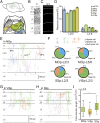Generation of a whole-brain atlas for the cholinergic system and mesoscopic projectome analysis of basal forebrain cholinergic neurons
- PMID: 29259118
- PMCID: PMC5777024
- DOI: 10.1073/pnas.1703601115
Generation of a whole-brain atlas for the cholinergic system and mesoscopic projectome analysis of basal forebrain cholinergic neurons
Abstract
The cholinergic system in the brain plays crucial roles in regulating sensory and motor functions as well as cognitive behaviors by modulating neuronal activity. Understanding the organization of the cholinergic system requires a complete map of cholinergic neurons and their axon arborizations throughout the entire brain at the level of single neurons. Here, we report a comprehensive whole-brain atlas of the cholinergic system originating from various cortical and subcortical regions of the mouse brain. Using genetically labeled cholinergic neurons together with whole-brain reconstruction of optical images at 2-μm resolution, we obtained quantification of the number and soma volume of cholinergic neurons in 22 brain areas. Furthermore, by reconstructing the complete axonal arbors of fluorescently labeled single neurons from a subregion of the basal forebrain at 1-μm resolution, we found that their projections to the forebrain and midbrain showed neuronal subgroups with distinct projection specificity and diverse arbor distribution within the same projection area. These results suggest the existence of distinct subtypes of cholinergic neurons that serve different regulatory functions in the brain and illustrate the usefulness of complete reconstruction of neuronal distribution and axon projections at the mesoscopic level.
Keywords: basal forebrain; cholinergic neurons; single neuron reconstruction; tomography; whole-brain imaging.
Conflict of interest statement
The authors declare no conflict of interest.
Figures




References
-
- Sarter M, Hasselmo ME, Bruno JP, Givens B. Unraveling the attentional functions of cortical cholinergic inputs: Interactions between signal-driven and cognitive modulation of signal detection. Brain Res Brain Res Rev. 2005;48:98–111. - PubMed
-
- Szymusiak R. Magnocellular nuclei of the basal forebrain: Substrates of sleep and arousal regulation. Sleep. 1995;18:478–500. - PubMed
-
- Everitt BJ, Robbins TW. Central cholinergic systems and cognition. Annu Rev Psychol. 1997;48:649–684. - PubMed
Publication types
MeSH terms
LinkOut - more resources
Full Text Sources
Other Literature Sources
Molecular Biology Databases
Miscellaneous

